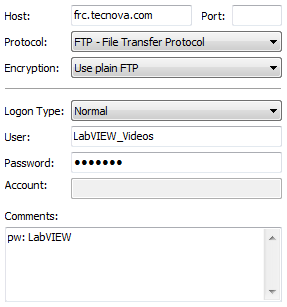-
Posts
607 -
Joined
-
Last visited
-
Days Won
41
Content Type
Profiles
Forums
Downloads
Gallery
Posts posted by Mark Balla
-
-
I have decide that if more than one class uses a typedef than is belongs to neither so it goes in a common location.
I do have to find out all the typedefs that are used before copying a class. But prefer it to the coupling of classes that is created when one of them owns the typedef.
Dmitry Sagatelyan's 2018 NIWeek presentation SOLID Actor Programming had an interesting solution to this issue. He creates a application specific translation class. These classes are not intended for reuse and translate outputs from one class to inputs of another.
-
Thanks for the update.
We saw the auto download issue in testing and it appeared to be fixed for Chrome and IE for Windows.
None of my testers were using Macs so it is good to get that feedback.
I put a note about Firefox in the original post.
-
Please see this link for Video downloads
-
- Popular Post
- Popular Post
he information formally listed in this thread is no longer valid. The site is now offline. All the videos have been moved to dedicated event pages on the LabVIEW Wiki.
- https://labviewwiki.org/wiki/Events - LabVIEW Wiki
- https://www.youtube.com/channel/UCUiBucUImKZERoTzaOtHB5g/featured - Youtube Channel
QuoteTecnova has created a new LabVIEW Video site to replace the previous ftp server for downloading NIWeek and CLA Summit videos.Location: https://labviewvideo.tecnova.comLogin: LabVIEW_Videos (Not case sensitive)Pw: LabVIEW (case sensitive)Check out the LabVIEW Videos Tecnova site Demo to see all the features of the new site.For comment or feedback please email LabVIEWVideo@tecnova.comThanks to Tecnova Management for supporting the LabVIEW Community.Note: Testing has shown successful downloads using Chrome, IE and Edge for Windows and Safari for Macs.FireFox however tries to auto play the video and may not work like the other browsers.-
 9
9
-
I am not sure what the solution would look like but I would like to somehow combine Dereks solution with the LAVA Code repository.
Ideally we would use LAVA for discussion, ranking and finding and Git for code management and collaboration.
-
 1
1
-
-
LV Champion Derek Trepanier has developed a Git solution and did 2 presentation at the CLA summit
I am still working on getting all the CLA videos edited and uploaded. The new Tecnova video sharing site is a week away from going live.
So to keep the momentum going I have posted Derek's presentation on the link below so others can see his perspective.
https://drive.google.com/open?id=17mjooun62caeL6EcsCG2g1arpg-OoRhk
-
 2
2
-
-
Thank for the update on the crashing videos I will re format them and look into the issue.
Last Friday the old server that we are using crashed and so currently it is down.
No videos were lost
I.T. is working on a new solution but may take a week or two.
NI is also working on putting the videos on their Center of Excellence Vimeo site by June 30th
I will post updates when they become available.
-
Certified 1-5-17 placed in General Catagory
-
Certified on 09-27-17 and placed in General category
-
I will look to see what the ban rules are when I logon to the server tomorrow. It will only ban if a logon fails X amount of times and the ban is only temporary and no more than 24hrs.
Video 205 is Fab's presentation on technical wealth. She is editing the video and I hope to have it up this week. I will post when it is ready.
-
- Popular Post
- Popular Post
Please see this link for Video downloads
The NIWeek 2017 Videos are uploaded to the ftp server.Please see this link for information on downloading the videos.https://lavag.org/topic/19154-ni-week-2015-videos/#comment-115444-
 10
10
-
Certified 1-18-2017 Placed in General catagory
-
Also Fabiola and Delacor asked I add their videos to the mix.
Videos 201-203 are up on the ftp server and I uploaded them this morning
Delacor's videos are also on their youtube channel
-
 1
1
-
-
- Popular Post
- Popular Post
-
- Popular Post
- Popular Post
Please see the above link to download the videos
The NIWeek 2016 Videos are uploaded to the ftp server.Please see this link for information on downloading the videos.https://lavag.org/topic/19154-ni-week-2015-videos/#comment-115444-
 16
16
-
Certified June 17 2016 placed in Machine Vision and Imaging.
-
Certified 06-02-2016 and placed in the Hardware repository
-
The Tecnova FRC server is back online.
Thanks for your patients
I've added 3 videos from the 2015 CLA summit that cover features in 2014 sp1 and 2015
2015 CLA_00A_Jeff Kadosky_New Wire
2015 CLA_13_Rob Dye_Profile Buffer Allocation Tool in 2014SP1
2015 CLA_16_Jeff Kadosky_Round Table New Wire
Mark
-
 2
2
-
-
Apologies the Server is down due to a bad UPS battery and a power failure.
I will work with I.T. to get it back online this week.
Thank you for letting me know I will post when the server is back online.
Mark
-
There are several issues with MultiQ that I hoped to get feedback on. The main question is what people think about the concept itself (I am using LAVA as an idea exchange here, at the risk of getting most eyes on the bad parts of code :-)), could it be useful (perhaps not if you are already using JAMA/your message routing solution for example). -But there are other things; like how full queues should be handled.
Regular queues can go wild if no one is consuming the data and the length has not been limited, or you can block new production by setting a maximum number of elements. However, with a pub-sub design such behaviour becomes an even bigger problem; do you really want to halt publication because one subscriber is not consuming? Probably not, but sometimes you might...So should the solution support both, or simplify by choosing one of the two? How does the message routing solution deal with message flooding (I'll have another look at it later)?
One of main difference that I see between yours and mine is who is responsible for sending the messages (who's while loop sends the message).
In yours you appear to spawn a "distributor" and it receives and distributes the messages to the registered modules.
In my architecture the sender does all the work (Through the API)
- API finds the specific message registry using the name of the message
- In the registry is an array of all couriers that want to receive the message.
- The message is placed in each courier and the "Send" method is called
So mine requires the sender to create the copies and send the message to each recipient where yours delegates that responsibility to the distributor loop. In MultiQ Because every module depends on the distributor if it crashes or dies then all communication is lost. This is something that I struggled with in previous implementations. It will work and I know of at least 2 other CLAs that use this method but for me is creates an unnecessary dependency in the types of application I build.
-
Back in 2011 I posted a framework
https://lavag.org/topic/14566-message-routing-architecture/
It was inspired by a CLA presentation by Rob Humfeld (Who is the guy that taught me LabVIEW) called JAMA
The WOW factor for me was when he open 2 separate vis one generating data and one displaying data.
He created a third to detect spikes and ran it without stopping the other 2. The module ran and started receiving the waveform data and detected spikes.
After that he stopped the vi made changes and started it back up again without stopping the 2 running vis.
This was the type of architecture I was looking for so I took the ideas he had wrapped in an OOP framework.
Hopefully the graphics and example code explain the way it works.
The power of this framework is modules are totally decoupled from each other and do not depend on any other module.
They created, manage and destroy their own courier (transport mechanism)
They only receive messages that they register for.
Any module can send any message at any time this makes creating simulator quick and easy.
I find this framework especially useful when building test systems.
- Using the framework I will create an asynchronous modules for each major device in the system. These modules will connect to the hardware and monitor health and maintain connection.
- Next I will create a module that will be called synchronously by the test sequencer. Its purpose is to
- connect to the async module through the framework
- request and receive measurements via messages
- Pass results back to the sequencer
- Close down
This works because the framework allows any module to connect, communicate and die without adversely affecting other modules.
Mark
-
02 and 03 were combined into a single video as it was a part 1 and part 2 series.
12 has been removed at the presenter's request
-
- Popular Post
- Popular Post
In AQ and John McBee's presentation "2015 NIWeek_21_Computer Science for the G Programmer Year 2" They mention 3 other videos from previous years.-
2012 NIWeek_LabVIEW Classes State of the Art -
2014 NIWeek_02_LabVIEW OOP CS for the G Programmer -
2015 CLA_11_Dimitry Sagatelyan_Actor Programming Without AF
These videos have also been included in the NIWeek 2015 folderGo to this link for informationhttps://lavag.org/topic/19154-ni-week-2015-videos/Please see this link for Video downloads https://lavag.org/topic/20645-labview-videos-tecnova-download-site/
-
 3
3
-
- Popular Post
- Popular Post
The NIWeek 2015, 2016, 2017 Videos are compressed and ready for down load from Tecnova's ftp server
I would strongly recommend using an ftp client to transfer them to your computer.
A web browser may work but if you want to download multiple videos the ftp client makes things much easier.
My ftp client of choice is FileZilla and it is free.
FileZilla can be downloaded at http://filezilla-project.org/
If you are unfamiliar with FileZilla there is a youtube tutorial video found
ftp://frc.tecnova.com
login: LabVIEW_Videos
pw: LabVIEW
login and password is case sensitive.
if you are using Filezilla your site manager window will look like this.
Please Let me know if you find any issues with the videos
-
 13
13



NIWeek 2019 Sunday evening meetup
in NIWeek
Posted
Since the Gingerman is no longer in downtown Austin the a consensus has been formed and many of the LV enthusiast will be meeting at BANGER'S SAUSAGE HOUSE AND BEER GARDEN Sunday evening.
This is a few blocks from the convention center opposite direction of 6th street. Most people start arriving around 6:30-7 after dinner. Please come by if you are around Sunday evening.
Banger's Sausage House & Beer Garden
79, 81, & 81.5 Rainey St.
Austin, TX 78701
https://www.bangersaustin.com/#home